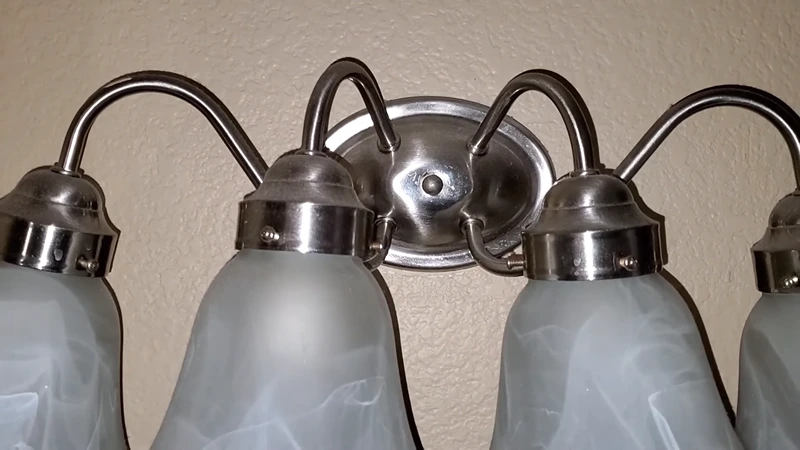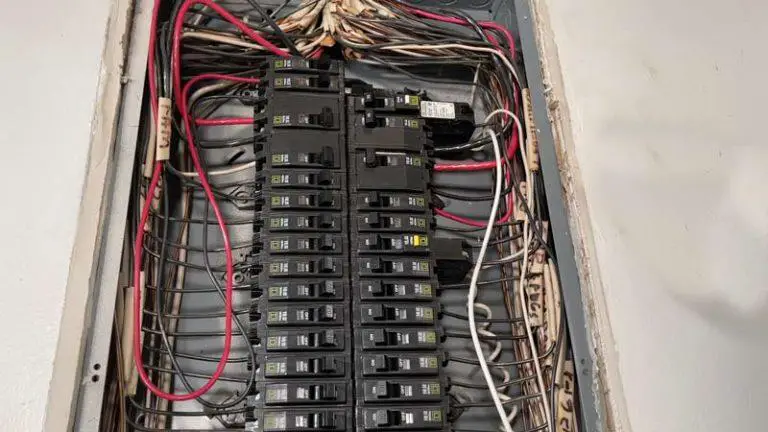Light Fixture Doesn’t Cover Junction Box [Proper Methods to Cover]

The problem of trying to install a light fixture that doesn’t cover the junction box is a common issue faced by homeowners and DIY enthusiasts during home renovation projects. This can be frustrating and potentially dangerous, as the open areas of the junction box may be exposed to live electrical wires.
It is important to find a safe and effective solution for covering open areas in order to protect yourself and others from electrical hazards. In this blog, we will explore the causes of this problem and discuss various solutions for dealing with it.
Light Fixture Doesn’t Cover Junction Box
Generally, you might have a light fixture that you are trying to install over a circular junction box. To cover the open areas in a safe and attractive way, you could try using a round cover plate with a hole in the center that is large enough to fit the rectangular light fixture.
Alternatively, you could remove the circular junction box and replace it with a rectangular one that is compatible with the light fixture. Keep in mind that it is important to follow the manufacturer’s instructions and any local building codes when installing electrical fixtures, and it is always a good idea to consult with a qualified electrician if you are unsure about how to proceed.
Junction Boxes and Light Fixtures
Types of Junction Boxes
- Circular: A circular junction box is shaped like a circle and is typically used to house electrical wires and connections. These boxes are often used in older homes and are designed to be covered by round light fixtures.
- Rectangular: A rectangular junction box is shaped like a rectangle and is typically used to house electrical wires and connections. These boxes are often used in newer homes and are designed to be covered by rectangular light fixtures.
- Octagonal: An octagonal junction box is shaped like an octagon and is typically used to house electrical wires and connections. These boxes are often used in homes with high ceilings or other specialty lighting applications and are designed to be covered by octagonal light fixtures.
- Square: A square junction box is shaped like a square and is typically used to house electrical wires and connections. These boxes are often used in homes with modern or minimalist design themes and are designed to be covered by square light fixtures.
Types of Light Fixtures
- Pendant: A pendant light fixture is a light that is suspended from the ceiling by a cord, chain, or rod. These fixtures are often used in kitchens, dining rooms, and other areas where task lighting is needed.
- Chandelier: A chandelier is a decorative light fixture that is suspended from the ceiling by a chain or rod. These fixtures are often used in formal dining rooms, living rooms, and other areas where ambient lighting is needed.
- Flush Mount: A flush mount light fixture is a light that is mounted directly to the ceiling without any visible cords or chains. These fixtures are often used in hallways, bedrooms, and other areas where a streamlined look is desired.
- Recessed: A recessed light fixture is a light that is installed in the ceiling, with only the trim and lightbulb visible. These fixtures are often used in kitchens, living rooms, and other areas where a clean, modern look is desired.
- Track Lighting: Track lighting is a type of light fixture that consists of a series of lights mounted on a track. These fixtures are often used in kitchens, living rooms, and other areas where task lighting is needed.
Causes of the Light Fixture Doesn’t Cover Junction Box
The causes are light fixtures aren’t compatible, lack of cover plate, and improper installation.
Light Fixtures That Are Not Compatible With the Junction Box
One of the main causes of the problem of trying to install a light fixture that doesn’t cover the junction box is that the light fixture itself is not compatible with the shape or size of the junction box. This can occur if the light fixture is designed to be installed over a different type of electrical box, such as a rectangular box instead of a circular one.
This can be frustrating for homeowners who may not realize that the light fixture and junction box are incompatible until after the light fixture has been purchased and delivered.
Lack of a Cover Plate or Other Protective Device
Another cause of the problem is the absence of a cover plate or other protective device that is designed to cover the open areas of the junction box.
Some light fixtures may come with a cover plate, but others may not. In these cases, it may be necessary to purchase a separate cover plate or find an alternative solution for covering the open areas.
Improper Installation
The problem of trying to install a light fixture that doesn’t cover the junction box can also occur due to improper installation. For example, if the light fixture is not securely attached to the junction box or if the wires are not properly connected, the open areas of the junction box may be exposed. This can be dangerous and may require the assistance of a qualified electrician to correct.
There are several other potential causes of the problem, including:
- Using a light fixture that is not UL Listed or not approved for use in the United States
- Installing the light fixture over a damaged or faulty junction box
- Using an improper mounting bracket or hardware to attach the light fixture to the junction box
- Installing the light fixture in a location that is not suitable for the type of light fixture being used
- Neglecting to follow the manufacturer’s instructions or local building codes when installing the light fixture.
Solutions to Light Fixture Doesn’t Cover Junction Box
Follow the manufacturer’s instructions and any local building codes when installing electrical fixtures: Proper installation is essential to ensuring the safety of electrical fixtures. To prevent the problem of trying to install a light fixture that doesn’t cover the junction box, it is important to follow the manufacturer’s instructions and any local building codes when installing electrical fixtures.
This includes selecting a light fixture that is compatible with the junction box, attaching the light fixture to the junction box securely, and making sure that the wires are properly connected. It is also a good idea to consult with a qualified electrician if you are unsure about how to proceed.
Use a Round Cover to Cover the Open Areas
One solution for dealing with a light fixture that doesn’t cover the junction box is to use a round cover plate with a hole in the center. To do this, you will need to locate a cover plate that is large enough to cover the open areas of the junction box and has a hole in the center that is large enough to fit the rectangular light fixture.
You will also need a screwdriver or drill and screws to attach the cover plate to the junction box. To install the cover plate, follow these steps:
- Turn off the power to the junction box by flipping the circuit breaker or removing the fuse.
- Remove the light fixture from the junction box.
- Hold the cover plate up to the junction box to ensure that it covers the open areas and that the hole in the center is the correct size.
- If necessary, use a drill or screwdriver to make any adjustments to the hole in the center of the cover plate.
- Place the cover plate over the junction box and use screws to attach it to the wall.
- Reattach the light fixture to the cover plate using the mounting hardware that was provided.
- Turn the power back on and test the light fixture to ensure that it is functioning properly.
Remove the Existing Junction Box
Another solution is to remove the existing junction box and replace it with a rectangular one that is compatible with the light fixture. To do this, you will need a screwdriver or drill and screws to remove the old junction box and install the new one.
You will also need to purchase a rectangular junction box that is the correct size and shape for your light fixture. To replace the junction box, follow these steps:
- Turn off the power to the junction box by flipping the circuit breaker or removing the fuse.
- Remove the light fixture from the junction box.
- Use a screwdriver or drill to remove the old junction box from the wall.
- Install the new junction box by following the manufacturer’s instructions and any local building codes.
- Attach the light fixture to the new junction box using the mounting hardware that was provided.
- Turn the power back on and test the light fixture to ensure that it is functioning properly.
Things You Should Care for When Installing Light Fixture
Here are some additional tips for dealing with a light fixture that doesn’t cover the junction box:
- Check the manufacturer’s warranty: If the light fixture was recently purchased and is still under warranty, it may be possible to get a replacement or a refund from the manufacturer. This is especially true if the problem is due to a defect in the light fixture itself.
- Consider using a junction box extension: If the junction box is too small to be covered by the light fixture, it may be possible to use a junction box extension to create more space. These extensions are available in various sizes and shapes and can be attached to the existing junction box to create additional space for the light fixture to cover.
- Use a device box cover: Another option is to use a device box cover, which is a protective cover that fits over the junction box and has an opening for the light fixture to fit through. These covers are available in various sizes and shapes and can be used to cover circular, rectangular, and other types of junction boxes.
- Invest in a UL Listed light fixture: To prevent future problems with light fixtures that don’t cover the junction box, it is important to invest in a UL Listed light fixture. UL Listed light fixtures have been tested and certified by Underwriters Laboratories, a leading safety consulting and certification company. This ensures that the light fixture meets safety standards and is approved for use in the United States.
- Follow proper installation procedures: Finally, it is important to follow proper installation procedures to ensure the safety of your electrical fixtures. This includes selecting a light fixture that is compatible with the junction box, attaching the light fixture to the junction box securely, and making sure that the wires are properly connected. If you are unsure about how to proceed, it is always a good idea to consult with a qualified electrician.
Final Words
The problem of trying to install a light fixture that doesn’t cover the junction box can be frustrating and potentially dangerous. However, there are several solutions available for dealing with this problem.
These include using a round cover plate with a hole in the center to cover the open areas, removing the existing junction box and replacing it with one that is compatible with the light fixture, and following the manufacturer’s instructions and any local building codes when installing electrical fixtures.
It is important to carefully consider the best solution for your specific situation and to take the necessary precautions to ensure the safety of yourself and others. Always remember to follow proper installation procedures to ensure the safety of your electrical fixtures and your home.




